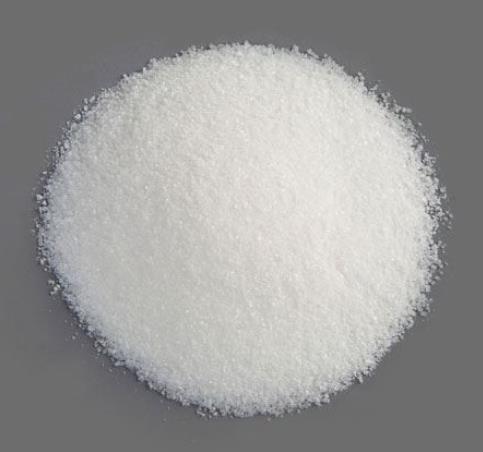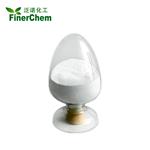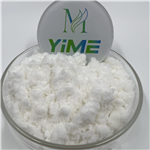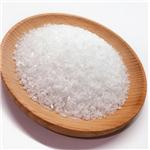Sorbic acid
- CAS No.
- 110-44-1
- Chemical Name:
- Sorbic acid
- Synonyms
- sorbic;2,4-HEXADIENOIC ACID;Panosorb;Sorbistat;(E,E)-Sorbic acid;2,4-HEXANEDIENOIC ACID;hexa-2,;FEMA 3921;C6:2n-2,4;NSC 35405
- CBNumber:
- CB1748891
- Molecular Formula:
- C6H8O2
- Molecular Weight:
- 112.13
- MDL Number:
- MFCD00002703
- MOL File:
- 110-44-1.mol
- MSDS File:
- SDS
| Melting point | 132-135 °C (lit.) |
|---|---|
| Boiling point | 228°C |
| Density | 1.2 g/cm3 at 20 °C |
| vapor pressure | 0.01 mm Hg ( 20 °C) |
| FEMA | 3921 | 2,4-HEXADIENOIC ACID, (E,E)- |
| refractive index | 1.4600 (estimate) |
| Flash point | 127 °C |
| storage temp. | 2-8°C |
| solubility | ethanol: 0.1 g/mL, clear |
| form | Crystalline Powder |
| pka | 4.76(at 25℃) |
| color | White or cream-white |
| PH | 3.3 (1.6g/l, H2O, 20°C) |
| Odor | bland |
| Water Solubility | 1.6 g/L (20 ºC) |
| Merck | 14,8721 |
| JECFA Number | 1176 |
| BRN | 1741831 |
| Stability | Material saturated with this acid may ignite spontaneously. Incompatible with strong oxidizing agents. May be light sensitive. |
| InChIKey | WSWCOQWTEOXDQX-MQQKCMAXSA-N |
| LogP | 1.32 at 20℃ |
| FDA 21 CFR | 182.3089; 582.3089; 181.23 |
| Substances Added to Food (formerly EAFUS) | SORBIC ACID |
| SCOGS (Select Committee on GRAS Substances) | Sorbic acid |
| CAS DataBase Reference | 110-44-1(CAS DataBase Reference) |
| EWG's Food Scores | 3 |
| FDA UNII | X045WJ989B |
| NIST Chemistry Reference | 2,4-Hexadienoic acid, (E,E)-(110-44-1) |
| EPA Substance Registry System | Sorbic acid (110-44-1) |
SAFETY
Risk and Safety Statements
| Symbol(GHS) |  GHS07 |
|||||||||
|---|---|---|---|---|---|---|---|---|---|---|
| Signal word | Warning | |||||||||
| Hazard statements | H315-H319 | |||||||||
| Precautionary statements | P264-P280-P302+P352-P305+P351+P338-P332+P313-P337+P313 | |||||||||
| Hazard Codes | Xi | |||||||||
| Risk Statements | 36/37/38-36/38 | |||||||||
| Safety Statements | 26-36-24/25 | |||||||||
| WGK Germany | 1 | |||||||||
| RTECS | WG2100000 | |||||||||
| F | 8 | |||||||||
| Autoignition Temperature | >130 °C | |||||||||
| TSCA | Yes | |||||||||
| HS Code | 29161930 | |||||||||
| Toxicity | LD50 orally in rats: 7.36 g/kg (Smyth, Carpenter) | |||||||||
| NFPA 704 |
|
Sorbic acid price More Price(39)
| Manufacturer | Product number | Product description | CAS number | Packaging | Price | Updated | Buy |
|---|---|---|---|---|---|---|---|
| Sigma-Aldrich | 82070 | Sorbic acid tested according to Ph. Eur. | 110-44-1 | 100g | $73.2 | 2024-03-01 | Buy |
| Sigma-Aldrich | 1.00662 | Sorbic acid EMPROVE? ESSENTIAL Ph Eur,BP,NF,FCC,E 200 | 110-44-1 | 5kg | $430 | 2024-03-01 | Buy |
| Sigma-Aldrich | 1615956 | Sorbic acid United States Pharmacopeia (USP) Reference Standard | 110-44-1 | 1g | $491 | 2024-03-01 | Buy |
| Sigma-Aldrich | 1.00662 | Sorbic acid EMPROVE? ESSENTIAL Ph Eur,BP,NF,FCC,E 200 | 110-44-1 | 25kg | $1551 | 2024-03-01 | Buy |
| Sigma-Aldrich | 47845 | Sorbic acid analytical standard | 110-44-1 | 1000mg | $21.8 | 2022-05-15 | Buy |
Sorbic acid Chemical Properties,Uses,Production
Description
Sorbic acid, also known as herbal tea acid, 2,4-hexadienoic acid,
2-propenyl acrylic acid, with molecular formula C6H8O2, is a food
additive that has inhibitory effects on many fungi such as yeast and
mold. It is also used in animal feed, cosmetics, pharmaceuticals,
packaging materials and rubber additives.
Chemical Properties
White, crystalline solid. Slightly soluble in water and many organic solvents. Combustible.
Chemical Properties
(E,E)-2,4-Hexadienoic acid has a characteristic odor.
History
Sorbic acid is a white crystalline solid first isolated in 1859 by hydrolysis of the oil distilled from unripened mountain-ash berries. The name is derived from the scientific term for the rowan tree, Sorbus aucuparia Linne, which is the parent plant of the mountain ash. Sorbic acid was first synthesized in 1900. Interest in this compound was minimal until independent researchers, E. Mueller of Germany and C.M. Gooding of the United States, discovered its antimicrobial effect in 1939 and 1940, respectively. Early interest in manufacturing sorbic acid centered around its use as a tung oil replacement when tung oil supplies were curtailed in the United States during World War II. High manufacturing costs prohibited expanded use until its approval as a food preservative in 1953. Sorbic acid is widely used in foods having a pH of 6.5 or below, where control of bacteria, molds, and yeasts is essential for obtaining safe and economical storage life.
Uses
Sorbic Acid is a preservative that is effective against yeasts and molds. it is effective over a broad ph range up to ph 6.5, being ineffective above ph 7.0. it is a white, free-flowing powder which is slightly soluble in water with a solubility of 0.16 g in 100 ml of water at 20°c. its solubility in water increases with increasing temperatures, although it is not recommended in foods that are pasteurized because it breaks down at high temperatures. the salts are potas- sium, calcium, and sodium sorbate. it is used in cheese, jelly, bever- ages, syrup, and pickles. typical usage levels range from 0.05 to 0.10%.
Uses
sorbic acid is a broad-spectrum, non-toxic preservative against molds and yeasts with moderate sensitizing potential in leave-on cosmetics. It is used in concentrations of 0.1 to 0.3 percent, and its activity is dependent on the formulation’s pH. Sorbic acid is used as a replacement for glycerin in emulsions, ointments, and various cosmetic creams. It is obtained from the berries of the tree commonly known as mountain ash and rowan, and can also be produced synthetically. Sorbic acid can cause irritation.
Uses
Sorbic Acid is an naturally occurring organic compound first isolated from unripe berries. Sorbic acid has been used as a food preservative and as an inhibitor of Clostridium Botulinum bacteria in mea t products in order to reduce the amount of nitrites which produce carcinogenic nitroamines.
Uses
Mold and yeast inhibitor. Fungistatic agent for foods, especially cheeses. To improve the characteristics of drying oils. In alkyd type coatings to improve gloss. To improve milling characteristics of cold rubber. See also Potassium Sorbate.
Definition
ChEBI: A sorbic acid having trans-double bonds at positions 2 and 4; a food preservative that can induce cutaneous vasodilation and stinging upon topical application to humans. It is the most thermodynamically stable of the four possible geometri isomers possible, as well as the one with the highest antimicrobial activity.
Reactions
The chemical reactivity of sorbic acid is determined by the conjugated double bonds and the carboxyl group.
Sorbic acid is brominated faster than other olefinic acids. Reaction with hydrogen chloride gives predominately 5-chloro-3-hexenoic acid. Reactions with amines at high temperatures under pressure lead to mixtures of dehydro-2-piperidinones. A yellow crystalline complex is formed from sorbic acid and iron tricarbonyl. Similar coordination occurs also in the presence of other di- and trivalent metals. Reduction of the double bonds can produce various hexenoic acid mixtures.
Biotechnological Production
Today, sorbic acid is produced solely by chemical synthesis. However, fermentation and chemical synthesis might be combined to develop a new production route for sorbic acid . In a first step, glucose would be converted to triacetic acid lactone by fermentation. It has been shown that triacetic acid lactone can be produced by genetically modified E. coli and S. cerevisiae strains. After a separation from the fermentation broth, triacetic acid lactone would be transformed into butyl sorbate in a multistage catalyst system (catalysis-hydrogenation and solid acid catalysis). Then, butyl sorbate would be purified and hydrolyzed to sorbic acid. Different scenarios are analyzed to evaluate the economic feasibility of such a production process .
Synthesis Reference(s)
Chemistry Letters, 10, p. 1289, 1981
Organic Syntheses, Coll. Vol. 3, p. 783, 1955
Tetrahedron Letters, 22, p. 69, 1981 DOI: 10.1016/0040-4039(81)80043-3
General Description
White powder or crystals. Melting point 134.5°C. Slightly acidic and astringent taste with a faint odor.
Air & Water Reactions
Soluble in hot water [Handbook of Chemistry and Physics]. May be sensitive to exposure to air and heat. The dust may become explosive, particularly when mixed with free-radical initiators or oxidizing agents. .
Reactivity Profile
Sorbic acid may discolor on exposure to light. Can react with oxidizing agents. Also incompatible with bases and reducing agents. The dust may become explosive, particularly when mixed with free-radical initiators or oxidizing agents .
Fire Hazard
Sorbic acid is combustible.
Biochem/physiol Actions
Sorbic acid can be used to inhibit bacterial, yeast and fungal sulfhydryl enzymes by inhibiting amino acid uptake.
Toxicology
Sorbic acid and its salts have broad-spectrum activity against yeast and molds, but are less active against bacteria. The antimicrobial action of sorbic acid was discovered independently in the United States and Germany in 1939, and since the mid-1950s sorbates have been increasingly used as preservatives. Sorbates generally have been found superior to benzoate for preservation of margarine, fish, cheese, bread, and cake. Sorbic acid and its potassium salts are used in low concentrations to control mold and yeast growth in cheese products, some fish and meat products, fresh fruits, vegetables, fruit beverages, baked foods, pickles, and wines. Sorbic acid is practically nontoxic. Table 10.4 shows acute toxicity of sorbic acid and its potassium salt. Animal studies have not shown obvious problems in tests performed with large doses for longer time periods. When sorbic acid (40 mg/kg/day) was injected directly into the stomach of male and female mice for 20 months, no differences were observed in survival rates, growth rates, or appetite between the injected mice and the control. When the dose was increased to 80 mg/kg/day for three additional months, however, some growth inhibition was observed. When potassium sorbate (1 and 2% in feed) was fed to dogs for three months, no pathological abnormalities were observed. This evidence indicates that the subacute toxicity of sorbic acid is negligible.
As a relatively new food additive, sorbate has been subject to stringent
toxicity-testing requirements. It may well be the most intensively studied
of all chemical food preservatives. In 90-day feeding studies in rats and dogs
and a lifetime feeding study in rats, a 5% dietary level of sorbates procured
no observable adverse effects. However, at a 10% dietary level in a 120-
day feeding study, rats showed increased growth and increased liver weight.
This has been attributed to the caloric value of sorbate at these high dietary
levels since it can act as a substrate for normal catabolic metabolism in
mammals. Sorbates are not mutagenic or tumorigenic, and as noted previously,
no reproductive toxicity has been observed.
Safety Profile
Moderately toxic by intraperitoneal and subcutaneous routes. Mildly toxic by ingestion. Experimental reproductive effects. A severe human and experimental skin irritant. Questionable carcinogen with experimental tumorigenic data. Mutation data reported. Combustible when exposed to heat or flame; can react with oxidizing materials. To fight fire, use water. When heated to decomposition it emits acrid smoke and irritating fumes.
Carcinogenicity
Wistar rats (six males) given subcutaneous
injections of 2mg sorbic acid, in 0.5mL of arachis
oil twice weekly for 65 weeks developed local sarcomas
. The first tumor was observed at 82 weeks.
Similar findings were also observed in follow-up studies
. However, six Wistar rats maintained on
drinking water containing 10 mg of sorbic acid/100mL
drinking water for 64 weeks did not develop tumors.
Tumors also were not observed inWistar rats (50 of each sex)
on diets that contained 40 mg/kg/day of sorbic acid for 18
months or in 25 male and female cross-bred white mice
after administration of 40 mg/kg/day for 17 months.
Mice fed a diet containing 15% sorbic acid for 88 weeks
exhibited a high incidence of hepatoma. Furthermore,
the glutathione level in the livers of the mice that ingested
15% sorbic acid decreased to 40% of the amount found in
controls after a 3-month feeding period; this low level was
maintained until the end of the experiments at 12 months.
There was a close correlation between the extent of depletion
of the glutathione level in the liver and the concentration
of sorbic acid added to the diet. In the same strain of mice fed
a diet containing 15% sorbic acid for up to 6 months, the
acidic fraction of an ether extract showed slight mutagenic
activity in an Ames test with Salmonella typhimurium TA98
in the presence of a liver 9000-g supernatant.
Consequently, the hepatomas that developed in mice fed a
15% sorbic acid diet were considered to be induced both by
the chronic depletion of the hepatic glutathione and by the
gradual production of various promutagens in the intestine,
which were absorbed and metabolically activated by the
liver.
storage
+4°C
Purification Methods
Crystallise the acid from water. Dry it air or in a desiccator over P2O5. [Beilstein 2 IV 1701.]
Sorbic acid Preparation Products And Raw materials
Raw materials
1of4
Preparation Products
1of2
| Supplier | Tel | Country | ProdList | Advantage | |
|---|---|---|---|---|---|
| Hebei Dangtong Import and export Co LTD | +8615632927689 | admin@hbdangtong.com | China | 991 | 58 |
| Shaanxi Haibo Biotechnology Co., Ltd | +undefined18602966907 | qinhe02@xaltbio.com | China | 1000 | 58 |
| Across Biotech Jinan Co LTD | +8613031735486 | frank@acrossbiotech.com | China | 105 | 58 |
| Wuhan Quanjinci New Material Co.,Ltd. | +8615271838296 | kyra@quanjinci.com | China | 1532 | 58 |
| Hebei Jingbo New Material Technology Co., Ltd | +8619931165850 | hbjbtech@163.com | China | 1000 | 58 |
| airuikechemical co., ltd. | +undefined86-15315557071 | sales02@airuikechemical.com | China | 994 | 58 |
| Shaanxi TNJONE Pharmaceutical Co., Ltd | +8618740459177 | sarah@tnjone.com | China | 893 | 58 |
| Henan Tianfu Chemical Co.,Ltd. | +86-0371-55170693 +86-19937530512 | info@tianfuchem.com | China | 21691 | 55 |
| Hangzhou FandaChem Co.,Ltd. | 008657128800458; +8615858145714 | fandachem@gmail.com | China | 9348 | 55 |
| Hefei TNJ Chemical Industry Co.,Ltd. | +86-0551-65418679 +86-18949832763 | info@tnjchem.com | China | 2989 | 55 |
Related articles
- Application of Sorbic acid
- Sorbic acid, also known as herbal tea acid, 2,4-hexadienoic acid, 2-propenyl acrylic acid.
- Mar 29,2022
View Lastest Price from Sorbic acid manufacturers
| Image | Update time | Product | Price | Min. Order | Purity | Supply Ability | Manufacturer | |
|---|---|---|---|---|---|---|---|---|
 |
2024-04-26 | Sorbic acid
110-44-1
|
US $2.00 / kg | 1kg | ≥99% | 1000mt/year | Jinan Finer Chemical Co., Ltd | |
 |
2024-04-26 | Sorbic acid
110-44-1
|
US $15.00 / kg | 1kg | 99% | 1000kg/month | Hebei Yime New Material Technology Co., Ltd. | |
 |
2024-04-26 | Sorbic acid
110-44-1
|
US $50.00-40.00 / kg | 1kg | 99% | 20Tons | Hebei Dangtong Import and export Co LTD |
-

- Sorbic acid
110-44-1
- US $2.00 / kg
- ≥99%
- Jinan Finer Chemical Co., Ltd
-

- Sorbic acid
110-44-1
- US $15.00 / kg
- 99%
- Hebei Yime New Material Technology Co., Ltd.
-

- Sorbic acid
110-44-1
- US $50.00-40.00 / kg
- 99%
- Hebei Dangtong Import and export Co LTD
110-44-1(Sorbic acid)Related Search:
1of4







